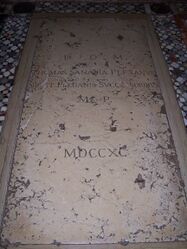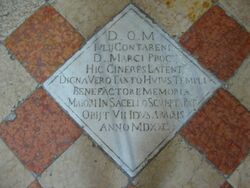Church Floor Artifacts: Difference between revisions
ChurchesB12 (talk | contribs) No edit summary |
ChurchesB12 (talk | contribs) No edit summary |
||
| Line 41: | Line 41: | ||
==Tombs== | ==Tombs== | ||
A tomb, or ''tomba'', is the most common form of floor artifact. These tomb artifacts | A tomb, or ''tomba'', is the most common form of floor artifact. These tomb artifacts mark the site of an actual grave, but do not necessarily still have remains in them, due to chaning Venetian laws and health concerns. A tomb marker may be either a large rectangle, giving the illusion that it does mark an eternal resting place, or a small square in remembrance of the deceased. Below is an example of both cases. | ||
<gallery widths=250px heights = 250> | <gallery widths=250px heights = 250> | ||
| Line 50: | Line 50: | ||
==Plaques== | ==Plaques== | ||
[[File:GESU 26.JPG|thumb|right|An Example Plaque from SS. Nome di Gesu]] | [[File:GESU 26.JPG|thumb|right|An Example Plaque from SS. Nome di Gesu]] | ||
A plaque, or ''placca'', is the second type of artifact. A plaque has an inscription, but is not a tomb. They often represent years of construction/restoration or prominent contributors. Plaques are less common than tombs, and are often smaller slabs. Below is an example of a plaque. | A plaque, or ''placca'', is the second type of artifact. A plaque has an inscription, but is not a tomb. They often represent years of construction/restoration or prominent contributors. Plaques are less common than tombs, and are often smaller slabs. A plaque did not ever mark the location of remains. Below is an example of a plaque. | ||
| Line 57: | Line 57: | ||
==Condition Evaluation== | ==Condition Evaluation== | ||
In order to create a ranked list of artifact damage, an equation that takes into account five different types of damage assessed by past WPI projects was created. The types of damage taken into account are fading and wear, text readability, cracks, holes and joint gaps. The equation evolved through experimentation with weights to translate what can be seen visually on the artifacts (wear or fading letters) into a numeric score. After using the following equation to standarize the rankings assigned to each artifact, the conditions were divided into five categories of damage. | In order to create a ranked list of artifact damage, an equation that takes into account five different types of damage assessed by past WPI projects was created. The types of damage taken into account are fading and wear, text readability, cracks, holes and joint gaps. <ref>Gagnon, Davidm Thompson, Kelly, Ruscitti, Eric. ''Embedded Heritage: A Study of Venetian Church Floors.'' An Interactive Qualifying Project for Worcester Polytechnic Institute. 2005. </ref> The equation evolved through experimentation with weights to translate what can be seen visually on the artifacts (wear or fading letters) into a numeric score. After using the following equation to standarize the rankings assigned to each artifact, the conditions were divided into five categories of damage. | ||
(0.25)(Fading and wear)+(0.25)(Readability) +(0.20)(Cracks)+(0.05)(Holes)+(0.20)(Joint gaps) | (0.25)(Fading and wear)+(0.25)(Readability) +(0.20)(Cracks)+(0.05)(Holes)+(0.20)(Joint gaps) | ||
| Line 65: | Line 65: | ||
Excessive Damage- The | Excessive Damage- The artifact is too far degraded that no more information would be saved if the artifact were to undergo restoration. | ||
| Line 82: | Line 82: | ||
==See Also== | ==See Also== | ||
[[Churches]] | [[File:Lighter Churches with Artifacts.jpeg|600px|center|A map highlighting the Churches of Venice with assessed Church Floor Artifacts]] | ||
The map pictured here highlights the Churches of Venice with assessed Church Floor Artifacts. For a complete list of Churches in Venice, see [[Churches]]. | |||
==References== | |||
<references/> | |||
==Bibliography== | |||
Dechaine, Danielle, Hennessey, Meghan, Orszulak, Jeffrey, Rullmann, Kevin. ''Treasures Underfoot: Preserving Venice's Church Floor Artifacts.'' An Interactive Qualifying Project for Worcester Polytechnic Institute. 2012. | |||
S. Hoey, M. Kahan, P Marchetti, K Mazza. ''Convents, Palaces and Churches: Transformation of Historic Buildings and the Impact on Venice’s Neighborhoods.'' An Interactive Qualifying Project for Worcester Polytechnic Institute. 2003. | |||
Santos,Luiz G., Petrowski,Craig Peter, Kristant,Elaine Hazel, Delaive,Amanda Leigh. ''The Church Floors in Venice, Italy -- an Archeological Study and Analysis.'' An Interactive Qualifying Project for Worcester Polytechnic Institute. 2002. | |||
==External Links== | ==External Links== | ||
None | |||
Revision as of 13:47, 21 December 2012
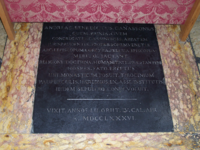 | |
| Churches with Assessed Artifacts | 74 |
|---|---|
| Total Number of Artifacts | 2221 |
| Number of Tombs | 1724 |
| Number of Plaques | 497 |
A church floor artifact is anything that was inlaid in the floor after construction. Typically, these artifacts contain inscriptions or are a different shape or material than the surrounding floor. Venetian church floor artifacts can be broken down into two categories, tombs and plaques. One of the reasons visitors choose to enter the churches of Venice is to view the artwork they contain. The artwork is not limited to sculptures and paintings displayed at eye level on the walls of building or on podiums in public squares. Many of Venice’s relics are found below eye level, in the floors of churches. Venetians used the materials available to decorate all aspects of their lives, including the ground they walked on. Some of these floor artifacts go unnoticed by visitors because they are overwhelmed by the other sights around them and forget to look at what is below their feet. Overlooking the floors of churches has not only allowed
these pieces to slip out of the minds of visitors, but has also led to neglect in their care and protection.
Artifact Breakdown

There are two types of artifacts that can be found within the Churches of Venice: Tombs and Plaques. The pie chart seen here shows the division of these. The blue portion of the graph shows the number of Tombs, while the smaller red part represents the number of plaques in the city.
Tombs
A tomb, or tomba, is the most common form of floor artifact. These tomb artifacts mark the site of an actual grave, but do not necessarily still have remains in them, due to chaning Venetian laws and health concerns. A tomb marker may be either a large rectangle, giving the illusion that it does mark an eternal resting place, or a small square in remembrance of the deceased. Below is an example of both cases.
-
A rectangular tomb
-
A smaller tomb marker
Plaques
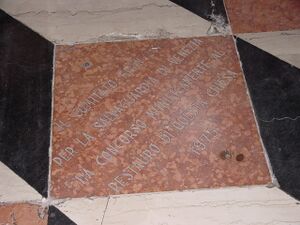
A plaque, or placca, is the second type of artifact. A plaque has an inscription, but is not a tomb. They often represent years of construction/restoration or prominent contributors. Plaques are less common than tombs, and are often smaller slabs. A plaque did not ever mark the location of remains. Below is an example of a plaque.
Condition Evaluation
In order to create a ranked list of artifact damage, an equation that takes into account five different types of damage assessed by past WPI projects was created. The types of damage taken into account are fading and wear, text readability, cracks, holes and joint gaps. [1] The equation evolved through experimentation with weights to translate what can be seen visually on the artifacts (wear or fading letters) into a numeric score. After using the following equation to standarize the rankings assigned to each artifact, the conditions were divided into five categories of damage.
(0.25)(Fading and wear)+(0.25)(Readability) +(0.20)(Cracks)+(0.05)(Holes)+(0.20)(Joint gaps)
The five categories of damage are as follows:
Excessive Damage- The artifact is too far degraded that no more information would be saved if the artifact were to undergo restoration.
High Damage- The artifact is in need of preservation in order to maintain the image or text visable on the artifact. The text is still readable, but is in danger of being worn away.
Intermediate Damage- The artifact has sustained some damage in any of the above types of damage, but is still mostly readable. Preservation could occur, but the artifact is not yet in critical condition.
Low Damage- The artifact has very little damage on its surface. The text is nearly flawless and only minimal efforts would need to be made inorder to maintain the condition of the artifact
Minimal Damage- The artifact has hardly any damage, all the text and art work is readable. At this time, there is no need for preservation.
See Also
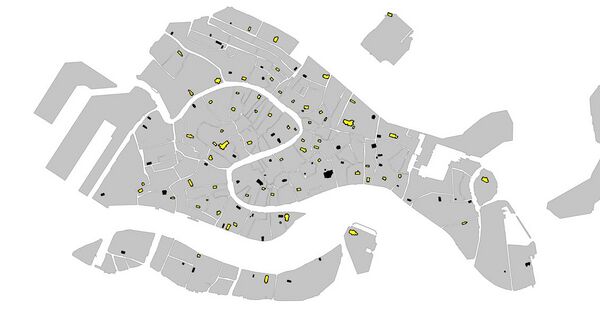
The map pictured here highlights the Churches of Venice with assessed Church Floor Artifacts. For a complete list of Churches in Venice, see Churches.
References
- ↑ Gagnon, Davidm Thompson, Kelly, Ruscitti, Eric. Embedded Heritage: A Study of Venetian Church Floors. An Interactive Qualifying Project for Worcester Polytechnic Institute. 2005.
Bibliography
Dechaine, Danielle, Hennessey, Meghan, Orszulak, Jeffrey, Rullmann, Kevin. Treasures Underfoot: Preserving Venice's Church Floor Artifacts. An Interactive Qualifying Project for Worcester Polytechnic Institute. 2012.
S. Hoey, M. Kahan, P Marchetti, K Mazza. Convents, Palaces and Churches: Transformation of Historic Buildings and the Impact on Venice’s Neighborhoods. An Interactive Qualifying Project for Worcester Polytechnic Institute. 2003.
Santos,Luiz G., Petrowski,Craig Peter, Kristant,Elaine Hazel, Delaive,Amanda Leigh. The Church Floors in Venice, Italy -- an Archeological Study and Analysis. An Interactive Qualifying Project for Worcester Polytechnic Institute. 2002.
External Links
None
